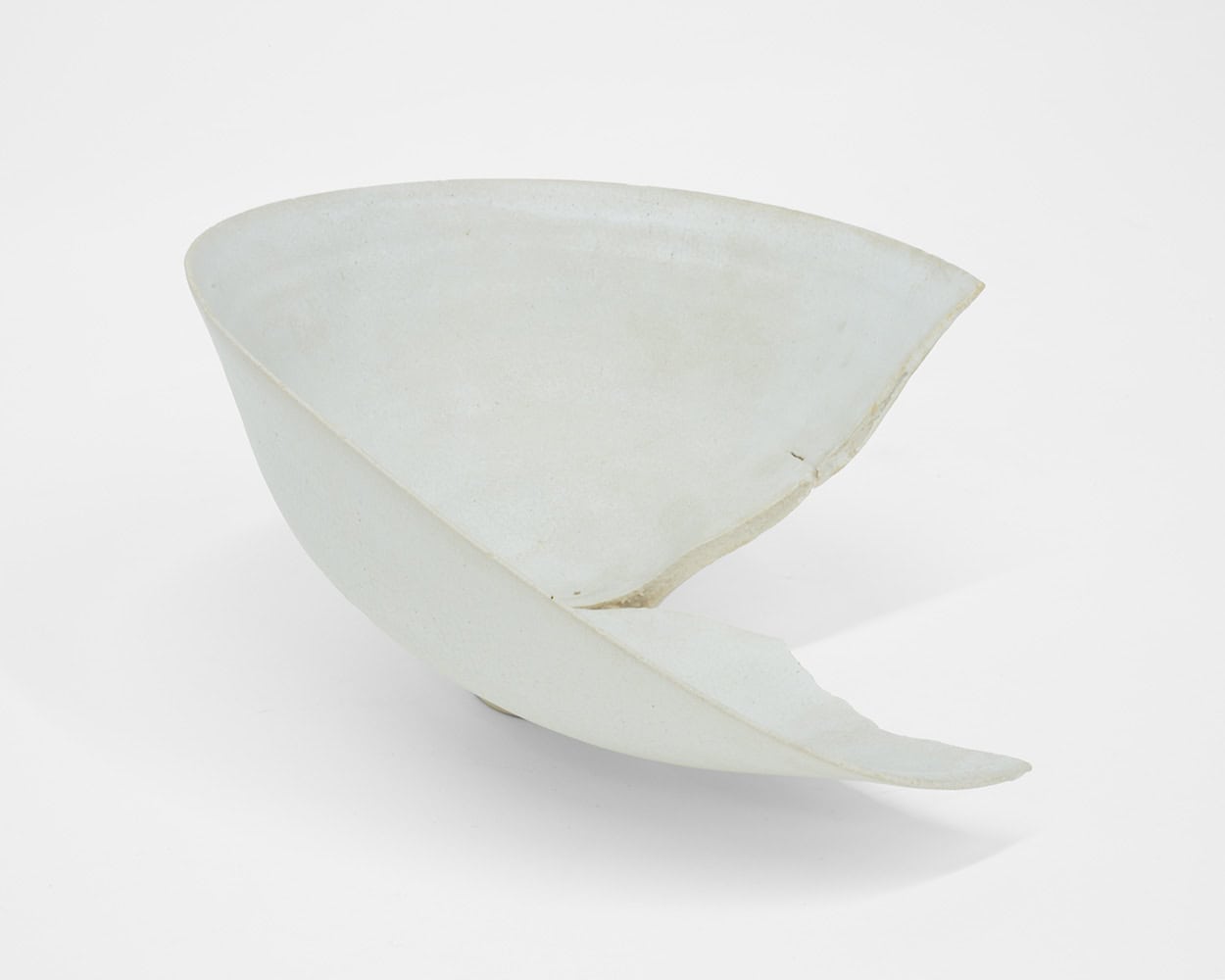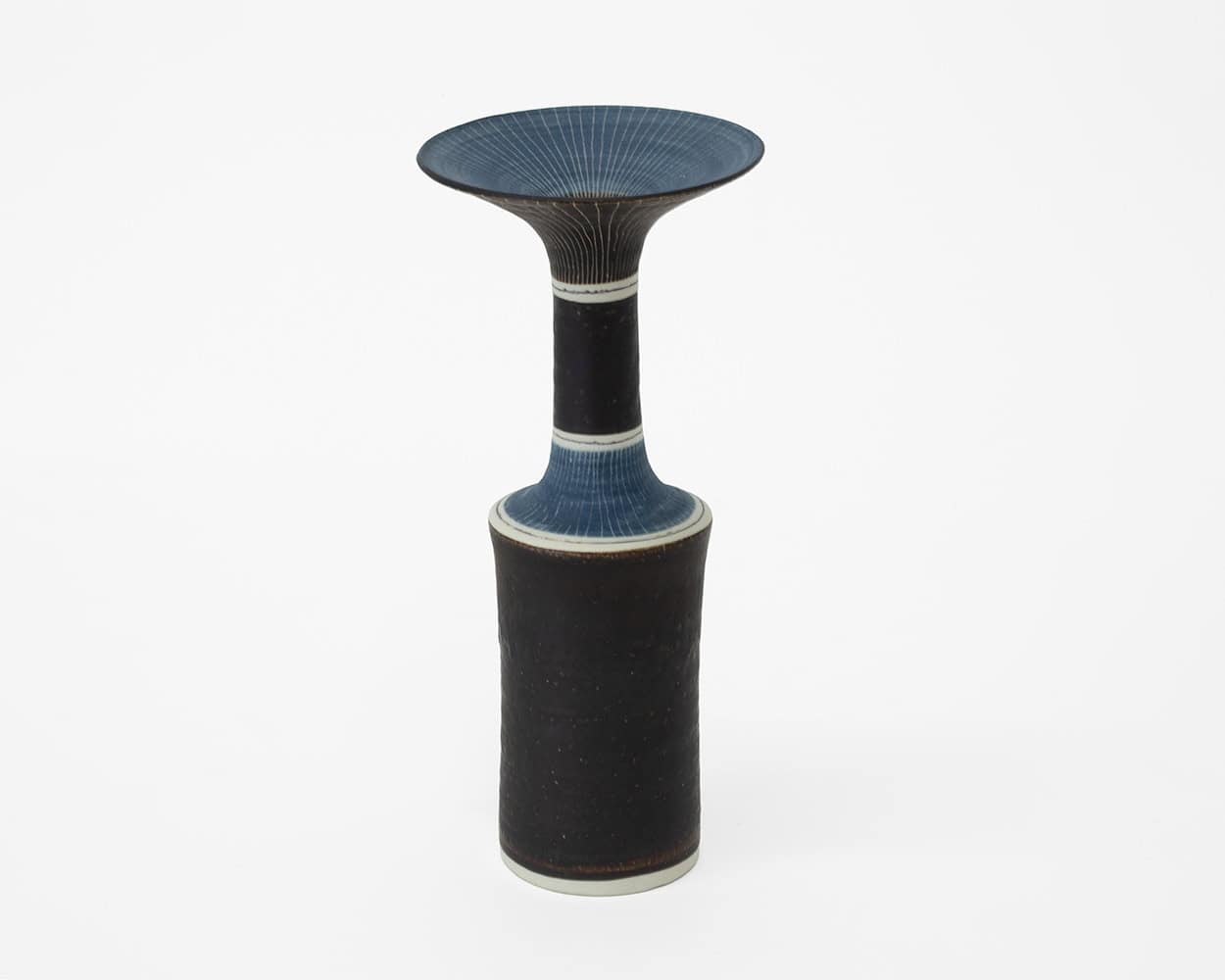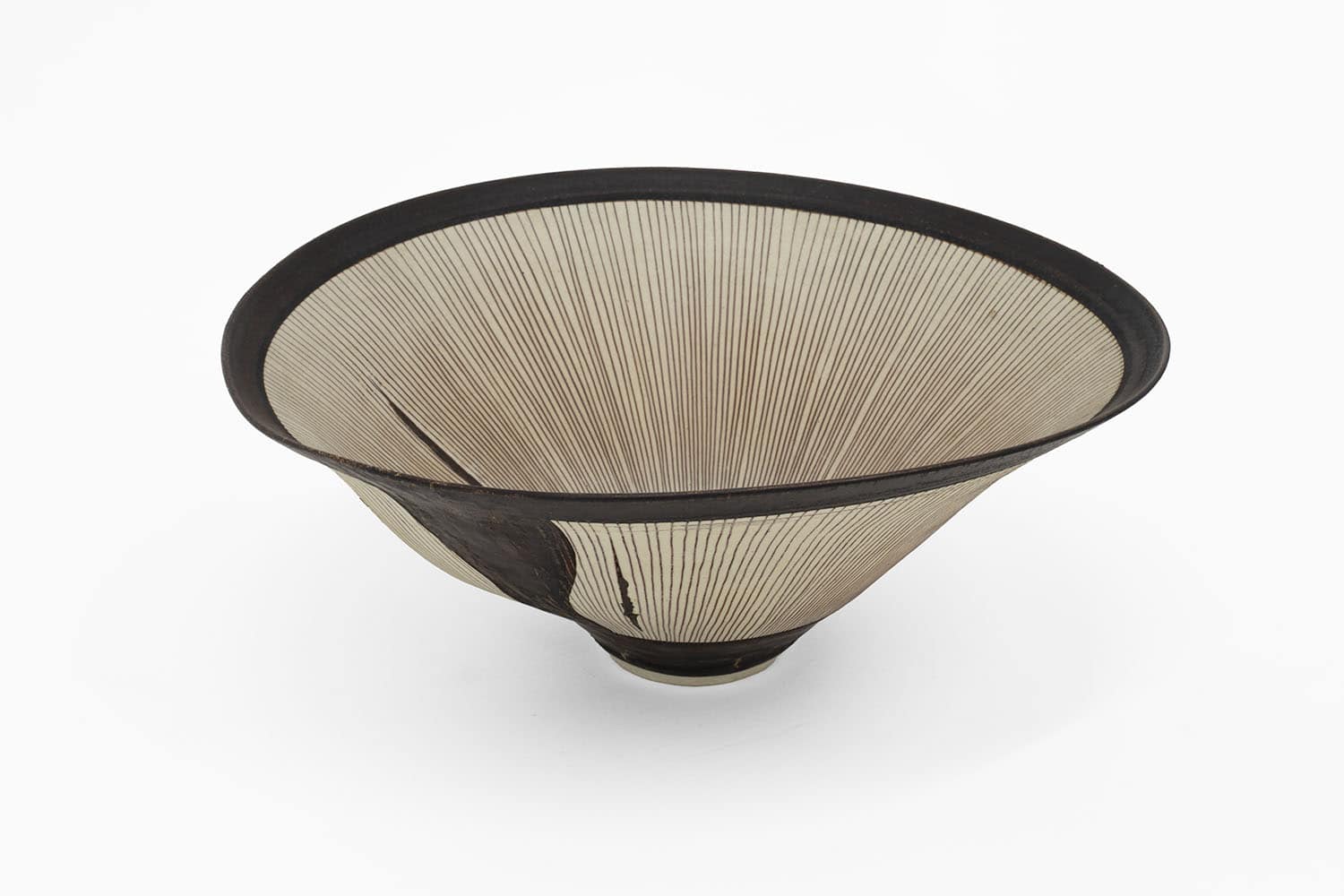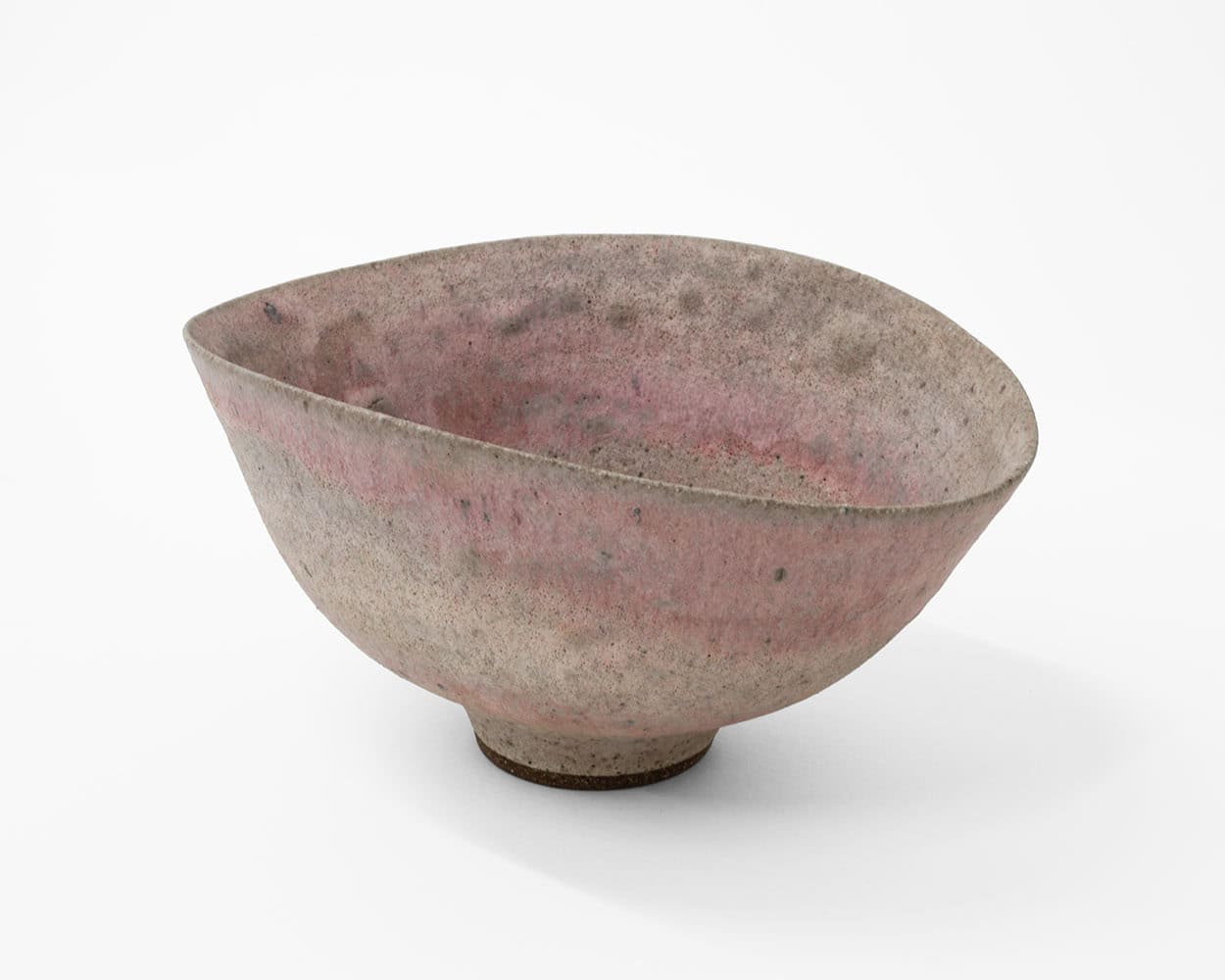To make pottery is an adventure to me, every new work is a new beginning. Indeed I shall never cease to be a pupil. There seems to the casual onlooker little variety in ceramic shapes and designs. But to the lover of pottery there is an endless variety of the most exciting kind. And there is nothing sensational about it, only a silent grandeur and quietness. If one should ask me whether I believe to be a modern potter or a potter of tradition I would answer, I don't know and I don't care. Art alive is always modern, not matter how old or young.
Lucie Riec. 1950

Lucie Rie, White Porcelain Bowl Split in Firing, c. 1978
While pottery and ceramics now pepper museums and galleries in Britain, during the 1930s and 1940s very few people understood pottery making as an artform. British studio pottery was dominated by the aesthetics and practices that honed the historic craft’s traditions of medieval British and Japanese ceramic aesthetics, exemplified in the work of potter Bernard Leach. In contrast to her contemporaries, while championing a female-led studio in a male-dominated practice, Lucie Rie’s style marked a departure from traditional decorative practice. Inspired by a different, Greco-Roman form of antiquity, Rie’s practice was deeply intertwined with modernist aesthetics and architectures—stripped back from over-decoration and made as one-off pieces. Her career-spanning fascination with form and experimentation led to visually striking works with intentional aesthetic simplicity, shaping the landscape of British ceramic practice in the process.
It was after attending Vienna Kunstgewerbeschule and studying under Josef Hoffmann and Michael Powolny, that Rie became wholly devoted to potting. While her pieces differ drastically from the aesthetics of either of her teachers, each imparted new approaches and principles—such as Hoffman’s luxurious simplicity—and that she adapted into her own distinctive style.
Working with clay from her twenties into her nineties, upon being suggested that she find a less labour-intensive practice by her friend David Attenborough, she proclaimed there was nothing else for her to pursue, she was a potter. Chasing this passion, her career was marked with experimentation and adaptation. Immigrating to London during World War II, she switched to making ceramic buttons and accessories to continue working with clay while assisting the war efforts. These buttons allowed her to not only host and collaborate with other refugee potters at her studio in Albion Mews, while generating income in post-war Britain, but also begin experimenting with glaze, colours, textures, and decors at a small scale before she was able to return to vases and bowls in 1946.

Lucie Rie, Vase with Flaring Rim, c. 1980
The result was pottery that transcended craft use and instead became an art object. Her pieces display her long history with artistic experimentation and rigorous honing of potting technique. While not overly decorative, each ceramic shows refined control in the glazes, the lines, and the form. Structural compositions, such as Vase with Flaring Rim (c. 1980), reveal her combination of delicate modes of decoration with modern architectural ideologies. Her works intimately reflect her time spent in London, viewing the city as a space of inspiration and making, with pottery as a means to capture this modernity.
While her pieces were met with criticism from her male contemporary potters in the first decade of working in London, by the 1950s a shift in British ceramics broke the industry away from traditional constraints and forms. Rie championed this era of experimentation in glazing, firing, and materiality as she unrelentingly continued to explore the aesthetic juxtaposition in mid-century potting between the modern and the craft, finding a harmony for ceramics in a modern context rather than at odds with the practice’s historicity.

Lucie Rie, Bowl with Off-White and Pitted Glaze with Bronzed Rim, c. 1982
Her bowls and vases reimagined traditional techniques, such as sgraffito, scratching, inlays, carving, and thick textural glazes applied with a brush rather than dipped. Playing with the layering of glazes, each one of her works is unique and one-of-one, with organic textures and patterns that bloom, spatter, and fluctuate across the vessel, as in Bowl with Off-White and Pitted Glaze with Bronzed Rim (c. 1982). Embracing this unpredictability, Rie found an endless adventure in creativity through working with clay, exploring the innate tensions within the material—the process of creating being destructive, the forces in play when using a wheel, fired pieces that display both strength and frailty. Pieces such as White Porcelain Bowl Split in Firing (c. 1978) did not take the form of a damaged bowl, but instead a visual proof of her process of experimentation and a testament to the dramatic tension within pottery.
Often taking inspiration from modernist architecture and natural referents, her ceramics evoke coral, pumice, and topographies through a refined palette, delicate mark making, and the unruly changes of fired glazes. Unlike many of her contemporary potters, her pieces were typically only fired once, with the glaze applied by brush while the clay was still raw, forming textures and colours that were incredibly vivid, almost as if alive. In the late 1940s, Rie switched from earthenware to stoneware and porcelain pottery, allowing her to make the walls of her works even more delicate. Combining this with sgraffito, she created luminous, painterly lines through the glaze that embraced the materiality and process of ceramic making.

Lucie Rie, Conical Bowl, c.1972
With simple forms and decorations quickly becoming signature to her style—as seen in Conical Bowl (c. 1972)—her practice stemmed not from a limited skillset, but instead from an artistry balancing innovation and subtle uniquity borne of a dedicated study to the interactions between glazing, mechanical decoration, firing, and skill at the wheel. Quotes from Rie exemplify this lifelong play and experimentation within the discipline, striving to meet her personal standards of artistic excellence. In her nineties, writing to a young potter Sebastian Blackie, Rie stated that she was still only just starting to understand clay
(By Teddy Woods)
